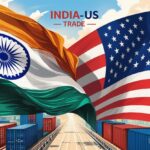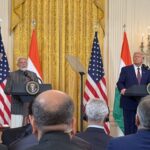The recent finalization of a sweeping trade agreement between the United States and the European Union on July 27, 2025, has significantly shifted the global trade landscape, placing India squarely in the crosshairs of the Trump administration’s aggressive tariff-driven trade strategy. With an August 1 deadline looming for other nations to conclude similar pacts, analysts from the Global Trade Research Initiative (GTRI) have cautioned New Delhi to meticulously scrutinize the terms, drawing lessons from the EU deal and previous U.S. agreements.
The U.S.-EU agreement, brokered at President Trump’s Turnberry resort, represents a critical development in Washington’s “Trade by Threat” approach. While it averted a threatened 30 per cent blanket tariff, the EU now faces a 15 per cent levy on most goods, a rate still significantly above pre-existing Most Favored Nation (MFN) levels. In return, the EU has committed to extensive tariff elimination on U.S. exports, substantial investments ($600 billion over three years), and significant purchases of U.S. energy ($750 billion) and defense equipment. This mirrors a consistent pattern observed in prior U.S. deals with the UK, Japan, Vietnam, and Indonesia.
GTRI’s analysis underscores that these agreements, despite being termed “deals,” diverge sharply from traditional Free Trade Agreements (FTAs). Under the Trump model, the U.S. imposes new tariffs (ranging from 10 per cent to 20 per cent above MFN rates) while securing near-complete tariff elimination and massive investment/purchase commitments from its partners, without reciprocal U.S. tariff cuts. This “one-sided” dynamic is concerning for India, which now finds itself at the forefront of Washington’s negotiating agenda.
“The EU deal, like its predecessors, showcases a strategy of compelled compliance rather than mutual cooperation,” stated Ajay Srivastava, GTRI founder. “The U.S. leverages the threat of prohibitive tariffs to extract deep concessions, including market access, regulatory alignment, and large-scale procurement pledges. India must understand that such agreements are fundamentally different from traditional trade liberalization efforts.”
For India, the potential U.S. deal could involve an approximate 15 per cent tariff on Indian exports to the U.S., in exchange for tariff reductions on U.S. goods entering India, substantial investment commitments, and easier regulatory access for American firms. This model raises significant questions about the true economic benefits for India, particularly given the U.S. administration’s demonstrated willingness to impose additional tariffs even on signed partners, as seen with the recent 10 per cent tariff threat against BRICS nations over “anti-American policies.”
GTRI’s report warned that “no deal is final” under the current U.S. trade policy, citing the shifting deadlines and unpredictable nature of tariff threats. India, having already submitted its final offer, now awaits Washington’s move, with an announcement potentially imminent.
While a trade agreement with the U.S., India’s largest trading partner, holds strategic importance, analysts urge New Delhi to prioritize long-term economic resilience over short-term relief from tariffs. Concerns linger about potential demands for opening sensitive sectors like agriculture and dairy, acceptance of genetically modified (GM) feed, and alignment with U.S. standards on digital trade and product regulations – areas where India has historically maintained a cautious stance.
“India must be exceedingly careful not to concede to imbalanced or excessive U.S. demands that could undermine its domestic industries, public health, and digital sovereignty,” Srivastava emphasized. “The pattern of these deals suggests they are more ‘Yielding to American Tariff Retaliation Agreements’ (YATRAs) than genuinely reciprocal partnerships. Any agreement must be based on transparent, public assessments of advantages and disadvantages, ensuring that concessions are fair, reciprocal, and aligned with India’s development needs.”
As the August 1 deadline approaches, India faces a critical diplomatic and economic challenge. The ability to secure a deal that genuinely serves its national interest, without compromising on critical policy space, will be a significant test of New Delhi’s strategic autonomy in an increasingly protectionist global trade environment.


![india us trade[1].jpg](https://southasianherald.com/wp-content/uploads/2025/07/india-us-trade1.jpg-1170x661.jpeg)



